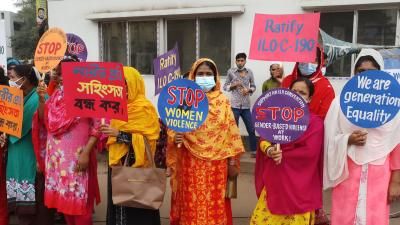Worldwide, men and women have different experiences of violence and harassment at work
This page is approximately a 3 minute read
This page was published on

While the World Risk Poll reveals that globally, men are fractionally more likely to report experience of violence and harassment at work than women, 22% vs. 20% respectively, it also shows that men and women have different experiences of violence and harassment in the workplace.
While both men and women say psychological harassment is the most common form they have experienced at work, the second most common experience for women is sexual violence and harassment (12%), followed by a combination of sexual and psychological violence and harassment (11%). In total, for a third (33%) of women who have experienced any violence and harassment at work, this included a sexual element.
The second most common experience for men is a combination of psychological and physical violence and harassment (20%), followed by physical violence and harassment alone (16%). In contrast to women, 15% of men’s experiences included a sexual element.
Safe at Work? Global experiences of violence and harassment
Read the reportRegional differences
There are also clear differences between men’s and women’s experiences of violence and harassment across regions. More women than men say they had experienced violence and harassment at work in Western regions, including Australia and New Zealand, North America, Northern/Western and Southern Europe, with the largest gap (13 percentage points) seen in North America.
Meanwhile, in all African regions, more men than women say they have experienced violence and harassment at work, with the largest gap (11 percentage points) seen in Southern Africa.
Dr. Sarah Cumbers Former Director of Evidence and Insight, Lloyd’s Register Foundation
For both men and women, the dominant form of violence and harassment experienced is psychological. However, the second and third most common type of experience for men and women differs significantly. This illustrates the importance of avoiding a one size fits all approach and using this data to understand the different experiences of different groups of people.

Education and income levels impacts experience
Globally, more people educated to university degree (tertiary) level say they have experienced violence and harassment while at work (26%), compared with 22% of people with a secondary-level education and 18% of people with a primary-level education or lower.
These differences at the global level are driven by women’s experiences. 29% of women who are educated to tertiary level say that they have experienced some form of violence and harassment at work, compared with 23% of men educated to the same level.
The opposite is true for those with a primary level education, as 22% of men in this group say they have experienced violence and harassment at work, compared to 15% of women. This highlights a 14 percentage point gap between women who are educated to tertiary level and to primary level. For men the equivalent gap is just one percentage point.
Differences between the sexes are also apparent when looking at country income groups. While people across countries of all income levels say they have experienced violence and harassment at work, it is only in high-income countries where more women than men say they have experienced violence and harassment (34% vs 26%).
Download the report

Safe at work? Global experiences of violence and harassment
This report explores individual experiences across countries and demographics around the world. It provides insight for regulators, businesses, governments, communities, and researchers to help them develop relevant policies to prevent harassment. (PDF, 4.73MB)